Geological Features, Paleosedimentary Environment, and Organic Matter Accumulation Mechanisms of the Lacustrine Shale Oil System: A Case Study of the Jurassic Dongyuemiao Member in the Sichuan Basin
Abstract
:1. Introduction
2. Geological Setting
3. Data and Method
3.1. Data
3.2. Methods
4. Results
4.1. Mineral Composition and OM Content
4.2. Major and Trace Elements
4.3. Pore System Characteristics
4.3.1. Pore System
4.3.2. Physical Properties
5. Discussion
5.1. Paleosedimentary Environment and Organic Matter Accumulation Mechanism
5.1.1. Paleoclimate and Weathering Conditions
5.1.2. Redox Conditions
5.1.3. Salinity Condition
5.1.4. Terrigenous Debris Influx and Primary Productivity
5.1.5. OM Accumulation Mechanisms
5.2. Controlling Factors for Physical Properties
5.3. Comparison of Geological Features of Lacustrine Shale Petroleum Systems
6. Conclusions
- The Dongyuemiao shale was deposited in an oxic and semi-humid environment with strong weathering. The enrichment of OM in the shale is primarily influenced by the redox condition and salinity. The redox condition plays the most critical role in OM accumulation.
- Based on the analysis of pores and minerals, three types of pores were identified in the Dongyuemiao shale: CMPs, OMPs, and FMPs. CMPs are the dominant pore type, while two types of OMPs were also observed. FMPs, on the other hand, are poorly developed and limited to certain siliceous and carbonate minerals.
- Although the TOC content of the Da’anzhai shale is slightly higher than that of the Dongyuemiao shale, the kerogen in the Dongyuemiao shale contains a higher hydrogen component, indicating greater hydrocarbon generation potential. Additionally, the Dongyuemiao shale exhibits better pore structure parameters. Therefore, the Dongyuemiao shale does not possess any significant disadvantages compared to the Da’anzhai shale, and it should be given more attention in future exploration efforts.
Author Contributions
Funding
Data Availability Statement
Conflicts of Interest
References
- Guo, T.L. Key controls on accumulation and high production of large non-marine gas fields in northern Sichuan Basin. Petrol. Explor. Dev. 2013, 40, 139–149. [Google Scholar] [CrossRef]
- Hu, T.; Pang, X.Q.; Jiang, S.; Wang, Q.F.; Zheng, X.W.; Ding, X.G.; Zhao, Y.; Zhu, C.X.; Li, H. Oil content evaluation of lacustrine organic-rich shale with strong heterogeneity: A case study of the Middle Permian Lucaogou Formation in Jimusaer Sag, Junggar Basin, NW China. Fuel 2018, 221, 196–205. [Google Scholar] [CrossRef]
- Li, C.R.; Pang, X.Q.; Huo, Z.P.; Wang, E.Z.; Xue, N. A revised method for reconstructing the hydrocarbon generation and expulsion history and evaluating the hydrocarbon resource potential: Example from the first member of the Qingshankou Formation in the Northern Songliao Basin, Northeast China. Mar. Pet. Geol. 2020, 121, 104577. [Google Scholar] [CrossRef]
- Liu, B.; Sun, J.H.; Zhang, Y.Q.; He, J.L.; Fu, X.F.; Yang, L.; Xing, J.L.; Zhao, X.P. Reservoir space and enrichment model of shale oil in the first member of Cretaceous Qingshankou Formation in the Changling Sag, southern Songliao Basin, NE China. Petrol. Explor. Dev. 2021, 48, 608–624. [Google Scholar] [CrossRef]
- Pang, X.Q.; Li, M.; Li, B.Y.; Wang, T.; Hui, S.S.; Liu, Y.; Liu, G.Y.; Hu, T.; Xu, T.W.; Jiang, F.J.; et al. Main controlling factors and movability evaluation of continental shale oil. Earth-Sci. Rev. 2023, 243, 104472. [Google Scholar] [CrossRef]
- Li, J.B.; Wang, M.; Jiang, C.Q.; Lu, S.F.; Li, Z. Sorption model of lacustrine shale oil: Insights from the contribution of organic matter and clay minerals. Energy 2022, 260, 125011. [Google Scholar] [CrossRef]
- Ma, Y.S.; Cai, X.Y.; Zhao, P.R.; Hu, Z.Q.; Liu, H.M.; Gao, B.; Wang, W.Q.; Li, Z.M.; Zhang, Z.L. Geological characteristics and exploration practices of continental shale oil in China. Acta Geol. Sin. 2022, 96, 155–171, (In Chinese with English Abstract). [Google Scholar]
- Wang, E.Z.; Feng, Y.; Guo, T.L.; Li, M.W. Oil content and resource quality evaluation methods for lacustrine shale: A review and a novel three-dimensional quality evaluation model. Earth-Sci. Rev. 2022, 232, 104134. [Google Scholar] [CrossRef]
- Wang, E.Z.; Li, C.R.; Feng, Y.; Song, Y.C.; Guo, T.L.; Li, M.W.; Chen, Z.H. Novel method for determining the oil moveable threshold and an innovative model for evaluating the oil content in shales. Energy 2022, 239, 121848. [Google Scholar] [CrossRef]
- Wang, E.Z.; Guo, T.L.; Li, M.W.; Xiong, L.; Dong, X.X.; Wang, T.; Ouyang, J.S. Reservoir characteristics and oil properties of a lacustrine shale system: Early Jurassic black shale from the Sichuan Basin, SW China. J. Asian Earth Sci. 2023, 242, 105491. [Google Scholar] [CrossRef]
- Wang, E.Z.; Guo, T.L.; Li, M.W.; Xiong, L.; Dong, X.X.; Wang, T.; Li, H.Q. Favorable Exploration Lithofacies and Their Formation Mechanisms in Lacustrine Shales Deposited under Different Salinity Conditions: Insights into Organic Matter Accumulation and Pore Systems. Energy Fuels 2023, 37, 11838–11852. [Google Scholar] [CrossRef]
- Jin, Z.J. Hydrocarbon accumulation and resources evaluation: Recent advances and current challenges. Adv. Geo-Energy Res. 2023, 8, 1–4. [Google Scholar] [CrossRef]
- Hu, T.; Wu, G.Y.; Xu, Z.; Pang, X.Q.; Liu, Y.; Yu, S. Potential resources of conventional, tight, and shale oil and gas from Paleogene Wenchang Formation source rocks in the Huizhou Depression. Adv. Geo-Energy Res. 2022, 6, 402–414. [Google Scholar] [CrossRef]
- Zou, C.N.; Dong, D.Z.; Wang, Y.M.; Li, X.J.; Huang, J.L.; Wang, S.F.; Guan, Q.Z.; Zhang, C.C.; Wang, H.Y.; Liu, H.L.; et al. Shale gas in China: Characteristics, challenges and prospects (II). Petrol. Explor. Dev. 2016, 43, 166–178. [Google Scholar] [CrossRef]
- Guo, X.S.; Hu, D.F.; Li, Y.P.; Wei, Z.H.; Wei, X.F.; Liu, Z.J. Geological factors controlling shale gas enrichment and high production in Fuling shale gas field. Petrol. Explor. Dev. 2017, 44, 481–491. [Google Scholar] [CrossRef]
- Wang, Y.F.; Zhai, G.Y.; Liu, G.H.; Shi, W.Z.; Lu, Y.C.; Li, J.; Zhang, Y.X. Geological Characteristics of Shale Gas in Different Strata of Marine Facies in South China. J. Earth Sci. 2021, 32, 725–741. [Google Scholar] [CrossRef]
- Liu, G.H.; Liu, B.; Liu, K.Y.; Zhai, G.Y.; Guo, Z.G. Silica crystallinity: Characteristics and controlling factors in marine shale of the upper Yangtze area, China. Mar. Pet. Geol. 2022, 151, 105833. [Google Scholar] [CrossRef]
- Feng, Y.; Xiao, X.M.; Gao, P.; Wang, E.Z.; Hu, D.F.; Liu, R.B.; Li, G.; Lu, C.G. Restoration of sedimentary environment and geochemical features of deep marine Longmaxi shale and its significance for shale gas: A case study of the Dingshan area in the Sichuan Basin, South China. Mar. Pet. Geol. 2023, 151, 106186. [Google Scholar] [CrossRef]
- Zou, C.N.; Yang, Z.; Zhao, Q.; Bai, W.H.; Liu, H.L.; Pan, S.Q.; Wu, S.T.; Yuan, Y.L. “Exploring petroleum inside source kitchen”: Shale oil and gas in Sichuan Basin. Sci. China Earth Sci. 2020, 63, 934–953. [Google Scholar] [CrossRef]
- Zhang, P.; Wang, Y.; Zhang, X.; Wei, Z.; Wang, G.; Zhang, T.; Ma, H.; Wei, J.; He, W.; Ma, X.; et al. Carbon, oxygen and strontium isotopic and elemental characteristics of the Cambrian Longwangmiao Formation in South China: Paleoenvironmental significance and implications for carbon isotope excursions. Gondwana Res. 2022, 106, 174–190. [Google Scholar]
- Zhang, P.; Wang, Y.; Wei, Z.; Wang, G.; Zhang, T.; He, W.; Ma, X.Y.; Ma, H.; Wei, J.Y.; Zhu, C.X. Influence of the late Ordovician-early Silurian paleoenvironment and related geological processes on the organic matter accumulation and carbon isotope excursion. Paleoceanogr. Paleoclimatology 2023, 38, e2023PA004628. [Google Scholar] [CrossRef]
- Yang, J.Q.; Zhang, J.T.; He, Z.L.; Zhang, T. Paleoenvironment reconstruction of the Middle Ordovician thick carbonate from western Ordos Basin, China. Pet. Sci. 2023, 20, 48–59. [Google Scholar] [CrossRef]
- Liu, M.; Sun, P.; Them II, T.R.; Li, Y.F.; Sun, S.L.; Gao, X.Y.; Huang, X.; Tang, Y.J. Organic geochemistry of a lacustrine shale across the Toarcian Oceanic Anoxic Event (Early Jurassic) from NE China. Glob. Planet. Change 2020, 191, 103214. [Google Scholar] [CrossRef]
- Jin, X.; Shi, Z.Q.; Baranyi, V.; Kemp, D.B.; Han, Z.; Luo, G.M.; Hu, J.F.; He, F.; Chen, L.; Preto, N. The Jenkyns Event (early Toarcian OAE) in the Ordos Basin, North China. Glob. Planet. Chang. 2020, 193, 103273. [Google Scholar] [CrossRef]
- Fu, X.P.; Yang, T. Pore structure of continental shale reservoirs in Lower Jurassic Ziliujing Formation, northeastern Sichuan Basin. Pet. Geol. Exp. 2021, 43, 589–598. [Google Scholar]
- Qiu, Z.; He, J.L. Depositional environment changes and organic matter accumulation of Pliensbachian-Toarcian lacustrine shales in the Sichuan basin, SW China. J. Asian Earth Sci. 2022, 232, 105035. [Google Scholar] [CrossRef]
- Li, Y.J.; Feng, Y.Y.; Liu, H.; Zhang, L.H.; Zhao, S.X. Geological characteristics and resource potential of lacustrine shale gas in the Sichuan Basin, SW China. Petrol. Explor. Dev. 2013, 40, 423–428. [Google Scholar] [CrossRef]
- Liu, S.G.; Yang, Y.; Deng, B.; Zhong, Y.; Wen, L.; Sun, W.; Li, Z.W.; Jansa, L.; Li, J.X.; Song, J.M.; et al. Tectonic evolution of the Sichuan Basin, Southwest China. Earth-Sci. Rev. 2021, 213, 103470. [Google Scholar] [CrossRef]
- Wang, E.Z.; Guo, T.L.; Li, M.W.; Xiong, L.; Dong, X.X.; Zhang, N.X.; Wang, T. Depositional Environment Variation and Organic Matter Accumulation Mechanism of Marine–Continental Transitional Shale in the Upper Permian Longtan Formation, Sichuan Basin, SW China. ACS Earth Space Chem. 2022, 6, 2199–2214. [Google Scholar] [CrossRef]
- Qiu, L.; Yan, D.P.; Tang, S.L.; Wang, Q.; Yang, W.X.; Tang, X.L.; Wang, J.B. Mesozoic geology of southwestern China: Indosinian foreland overthrusting and subsequent deformation. J. Asian Earth Sci. 2016, 122, 91–105. [Google Scholar] [CrossRef]
- Shao, T.B.; Cheng, N.F.; Song, M.S. Provenance and tectonic-paleogeographic evolution: Constraints from detrital zircon U–Pb ages of Late Triassic-Early Jurassic deposits in the northern Sichuan basin, central China. J. Asian Earth Sci. 2016, 127, 12–31. [Google Scholar] [CrossRef]
- Nie, H.K.; Jin, Z.J.; Li, P.; Katz, B.J.; Dang, W.; Liu, Q.Y.; Ding, J.H.; Jiang, S.; Li, D.H. Deep shale gas in the Ordovician-Silurian Wufeng–Longmaxi formations of the Sichuan Basin, SW China: Insights from reservoir characteristics, preservation conditions and development strategies. J. Asian Earth Sci. 2023, 244, 105521. [Google Scholar] [CrossRef]
- Faure, M.; Lepvrier, C.; Nguyen, V.V.; Vu, T.V.; Lin, W.; Chen, Z.C. The South China block-Indochina collision: Where, when, and how? J. Asian Earth Sci. 2014, 79, 260–274. [Google Scholar] [CrossRef]
- Halpin, J.A.; Tran, H.T.; Lai, C.K.; Meffre, S.; Crawford, A.J.; Zaw, K. U–Pb zircon geochronology and geochemistry from NE Vietnam: A ‘tectonically disputed’ territory between the Indochina and South China blocks. Gondwana Res. 2016, 2016, 254–273. [Google Scholar] [CrossRef]
- Taylor, S.R.; McLennan, S.M. The Continental Crust: Its Composition and Evolution; Blackwell: Oxford, UK, 1985; p. 312. [Google Scholar]
- Minyuk, P.S.; Brigham–Grette, J.; Melles, M.; Borkhodoev, V.Y.; Glushkova, O.Y. Inorganic geochemistry of El’gygytgyn Lake sediments (northeastern Russia) as an indicator of paleoclimatic change for the last 250 kyr. J. Paleolimnol. 2007, 37, 123–133. [Google Scholar] [CrossRef]
- Nesbitt, H.W.; Young, G.M. Early Proterozoic climates and plate motions inferred from major element chemistry of lutites. Nature 1982, 299, 715–717. [Google Scholar] [CrossRef]
- McLennan, S.M.; Hemming, S.; McDaniel, D.K.; Hanson, G.N. Geochemical approaches to sedimentation, provenance, and tectonics. Geol. Soc. Am. Spec. Pap. 1993, 284, 21–40. [Google Scholar]
- Zhao, Z.Y.; Zhao, J.H.; Wang, H.J.; Liao, J.D.; Liu, C.M. Distribution characteristics and applications of trace elements in Junggar basin. Nat. Gas Exp. Dev. 2007, 30, 30–33, (In Chinese with English Abstract). [Google Scholar]
- Loucks, R.G.; Reed, R.M.; Ruppel, S.C.; Jarvie, D.M. Morphology, genesis, and distribution of nanometer-scale pores in siliceous mudstones of the Mississippian Barnett Shale. J. Sediment. Res. 2009, 79, 848–861. [Google Scholar] [CrossRef]
- Chen, L.; Jiang, Z.X.; Liu, Q.X.; Jiang, S.; Liu, K.Y.; Tan, J.Q.; Gao, F.L. Mechanism of shale gas occurrence: Insights from comparative study on pore structures of marine and lacustrine shales. Mar. Pet. Geol. 2019, 104, 200–216. [Google Scholar] [CrossRef]
- Xia, G.Q.; Mansour, A. Paleoenvironmental changes during the early Toarcian Oceanic Anoxic Event: Insights into organic carbon distribution and controlling mechanisms in the eastern Tethys. J. Asian Earth Sci. 2022, 237, 105344. [Google Scholar] [CrossRef]
- Wu, Z.Y.; Zhao, X.Z.; Wang, E.Z.; Pu, X.G.; Lash, G.; Han, W.Z.; Zhang, W.; Feng, Y. Sedimentary environment and organic enrichment mechanisms of lacustrine shale: A case study of the Paleogene Shahejie Formation, Qikou Sag, Bohai Bay Basin. Palaeogeogr. Palaeoclimatol. Palaeoecol. 2021, 573, 110404. [Google Scholar] [CrossRef]
- Mansour, A.; Wagreich, M. Earth system changes during the cooling greenhouse phase of the Late Cretaceous: Coniacian-Santonian OAE3 subevents and fundamental variations in organic carbon deposition. Earth-Sci. Rev. 2022, 229, 104022. [Google Scholar] [CrossRef]
- Scott, C.; Lyons, T.W. Contrasting molybdenum cycling and isotopic properties in euxinic versus non-euxinic sediments and sedimentary rocks: Refining the paleoproxies. Chem. Geol. 2012, 324, 19–27. [Google Scholar] [CrossRef]
- Jones, B.; Manning, D.A. Comparison of geochemical indices used for the interpretation of palaeoredox conditions in ancient mudstones. Chem. Geol. 1994, 111, 111–129. [Google Scholar] [CrossRef]
- Khanehbad, M.; Moussavi-Harami, R.; Mahboubi, A.; Nadjafi, M. Geochemistry of Carboniferous Shales of the Sardar Formation, East Central Iran: Implication for Provenance, Paleoclimate and Paleo-oxygenation Conditions at a Passive Continental Margin. Geochem. Int. 2012, 50, 867–880. [Google Scholar] [CrossRef]
- Algeo, T.J.; Ingall, E. Sedimentary Corg: P ratios, paleocean ventilation, and Phanerozoic atmospheric pO2. Palaeogeogr. Palaeoclimatol. Palaeoecol. 2007, 256, 130–155. [Google Scholar] [CrossRef]
- Pan, Y.; Huang, Z.; Guo, X.; Wang, R.; Lash, G.G.; Fan, T.G.; Liu, W. A re-assessment and calibration of redox thresholds in the Permian Lucaogou Formation of the Malang Sag, Santanghu Basin, Northwest China. Mar. Pet. Geol. 2021, 135, 105406. [Google Scholar] [CrossRef]
- Wei, W.; Algeo, T.J. Elemental proxies for paleosalinity analysis of ancient shales and mudrocks. Geochim. Cosmochim. Acta 2020, 287, 341–366. [Google Scholar] [CrossRef]
- Tribovillard, N.; Desprairies, A.; Lallier-Vergès, E.; Bertrand, P.; Moureau, N.; Ramdani, A.; Ramanampisoa, L. Geochemical study of organic-matter rich cycles from the Kimmeridge Clay Formation of Yorkshire (UK): Productivity versus anoxia. Palaeogeogr. Palaeoclimatol. Palaeoecol. 1994, 108, 165–181. [Google Scholar] [CrossRef]
- Nie, Y.; Fu, X.G.; Liang, J.T.; Wei, H.Y.; Chen, Z.G.; Lin, F.; Zeng, S.Q.; Wu, Y.H.; Zou, Y.; Mansour, A. The Toarcian Oceanic Anoxic Event in a shelf environment (Eastern Tethys): Implications for weathering and redox conditions. Sediment. Geol. 2023, 455, 106476. [Google Scholar] [CrossRef]
- Reolid, M.; Rodriguez-Tovar, F.J.; Marok, A.; Sebane, A. The Toarcian oceanic anoxic event in the Western Saharan Atlas, Algeria (North African paleomargin): Role of anoxia and productivity. Geol. Soc. Am. Bull. 2012, 124, 1646–1664. [Google Scholar] [CrossRef]
- Tribovillard, N.; Algeo, T.J.; Lyons, T.; Riboulleau, A. Trace metals as paleoredox and paleoproductivity proxies: An update. Chem. Geol. 2006, 232, 12–32. [Google Scholar] [CrossRef]
- Kennedy, M.J.; Pevear, D.R.; Hill, R.J. Mineral surface control of organic carbon in black shale. Science 2002, 295, 657–660. [Google Scholar] [CrossRef]
- Ricken, W. Bedding rhythms and cyclic sequences as documented in organic carbon-carbonate patterns, Upper Cretaceous, Western Interior, U.S. Sediment. Geol. 1996, 102, 131–154. [Google Scholar] [CrossRef]
- Tyson, R.V. Sedimentation rate, dilution, preservation and total organic carbon: Some results of a modelling study. Org. Geochem. 2001, 32, 333–339. [Google Scholar] [CrossRef]
- Yang, G.Q.; Zeng, J.H.; Qiao, J.C.; Liu, Y.Z.; Liu, S.N.; Jia, W.T.; Cao, W.F.; Wang, C.Y.; Geng, F.; Wei, W.F. Role of organic matter, mineral, and rock fabric in the full-scale pore and fracture network development in the mixed lacustrine source rock system. Energy Fuels 2022, 36, 8161–8179. [Google Scholar] [CrossRef]
- Wang, E.Z.; Feng, Y.; Guo, T.L.; Li, M.W.; Xiong, L.; Lash, G.G.; Dong, X.X.; Wang, T.; Ouyang, J.S. Sedimentary differentiation triggered by the Toarcian Oceanic Anoxic Event and formation of lacustrine shale oil reservoirs: Organic matter accumulation and pore system evolution of the Early Jurassic sedimentary succession, Sichuan Basin, China. J. Asian Earth Sci. 2023, 256, 105825. [Google Scholar] [CrossRef]
- He, W.Y.; Bai, X.F.; Meng, Q.A.; Li, J.H.; Zhang, D.Z.; Wang, Y.Z. Accumulation geological characteristics and major discoveries of lacustrine shale oil in Sichuan Basin. Acta Pet. Sin. 2022, 43, 886–898, (In Chinese with English Abstract). [Google Scholar]
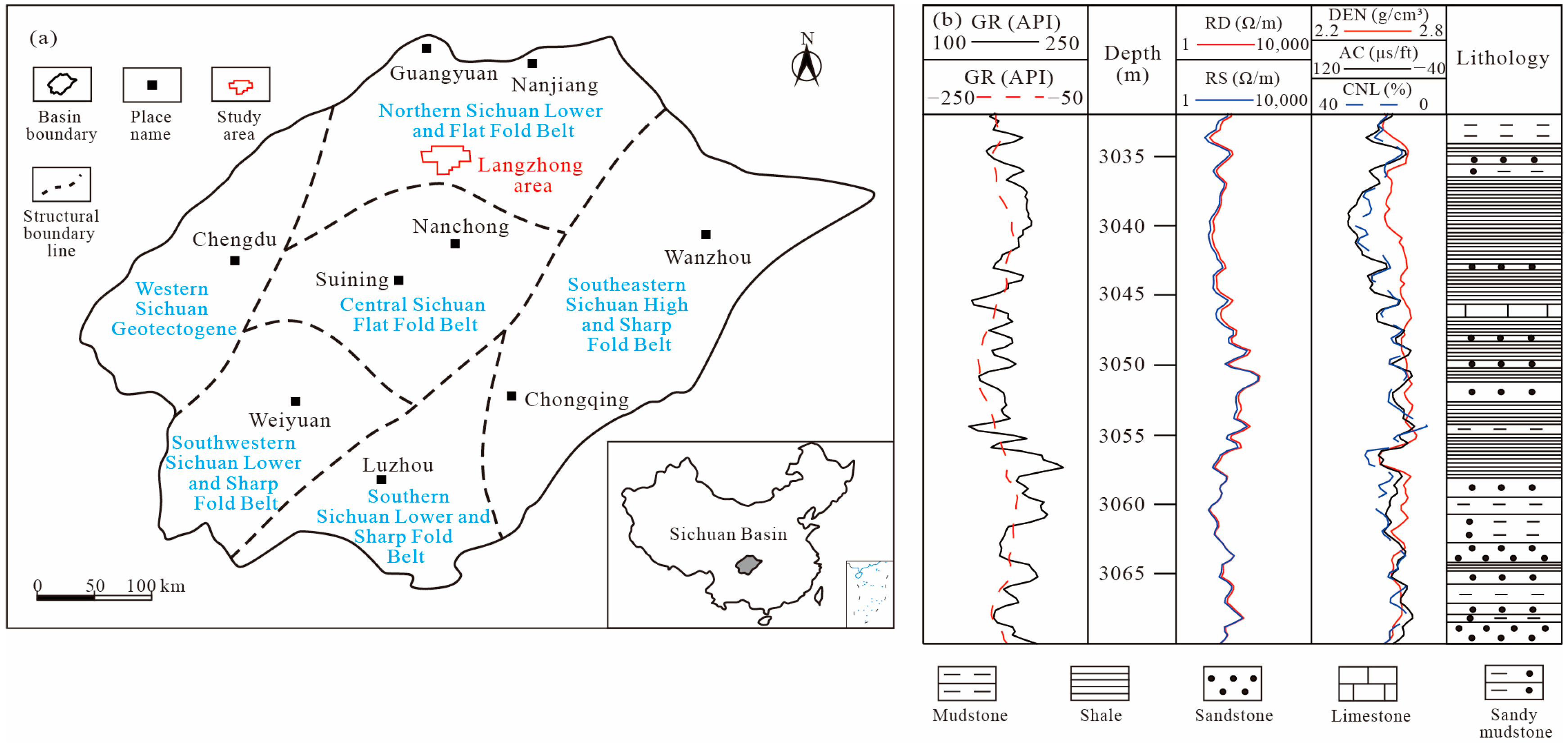
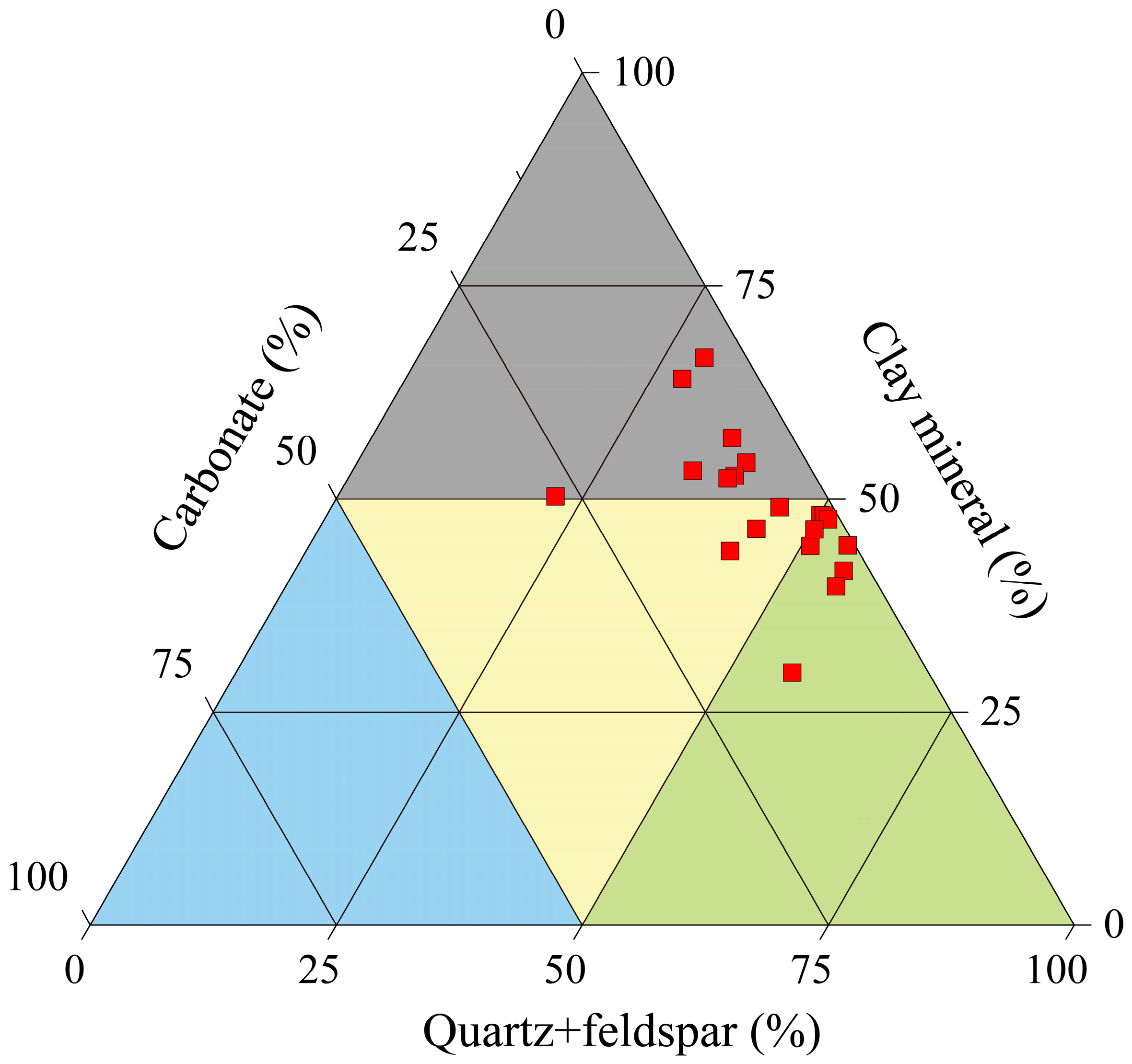
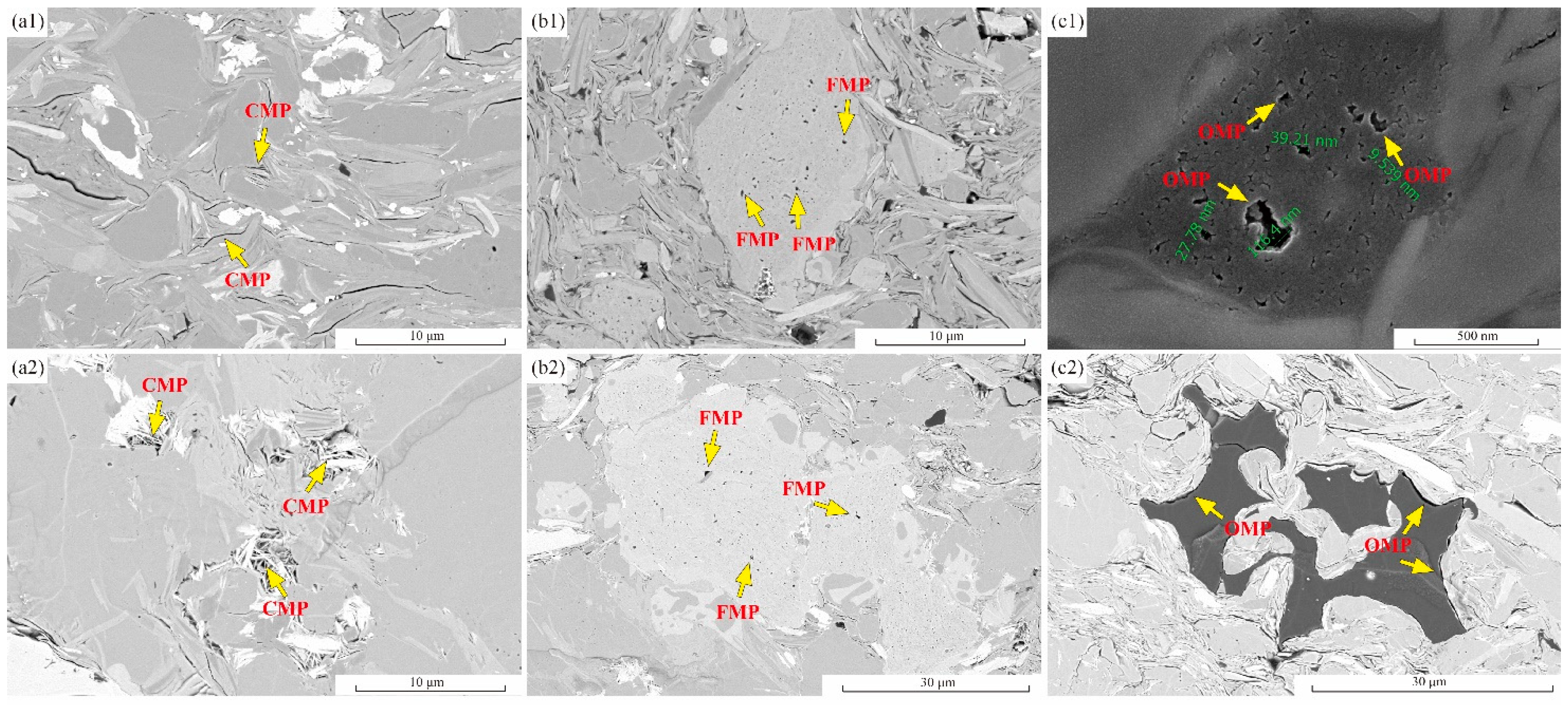
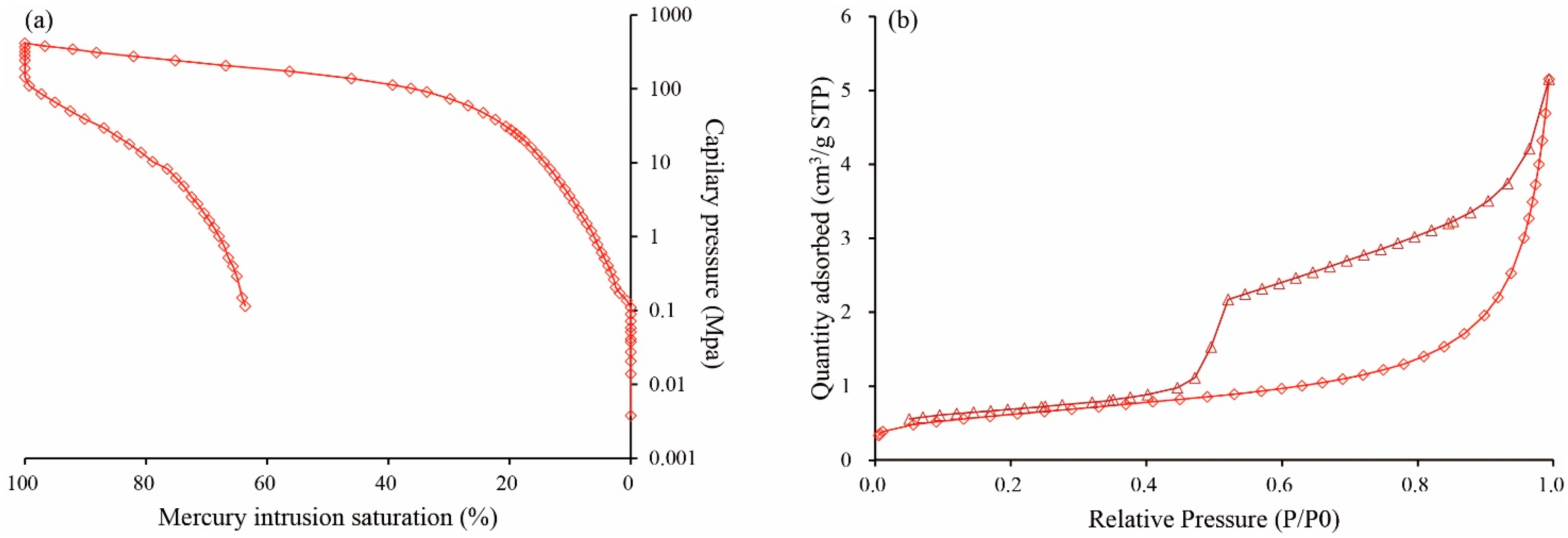
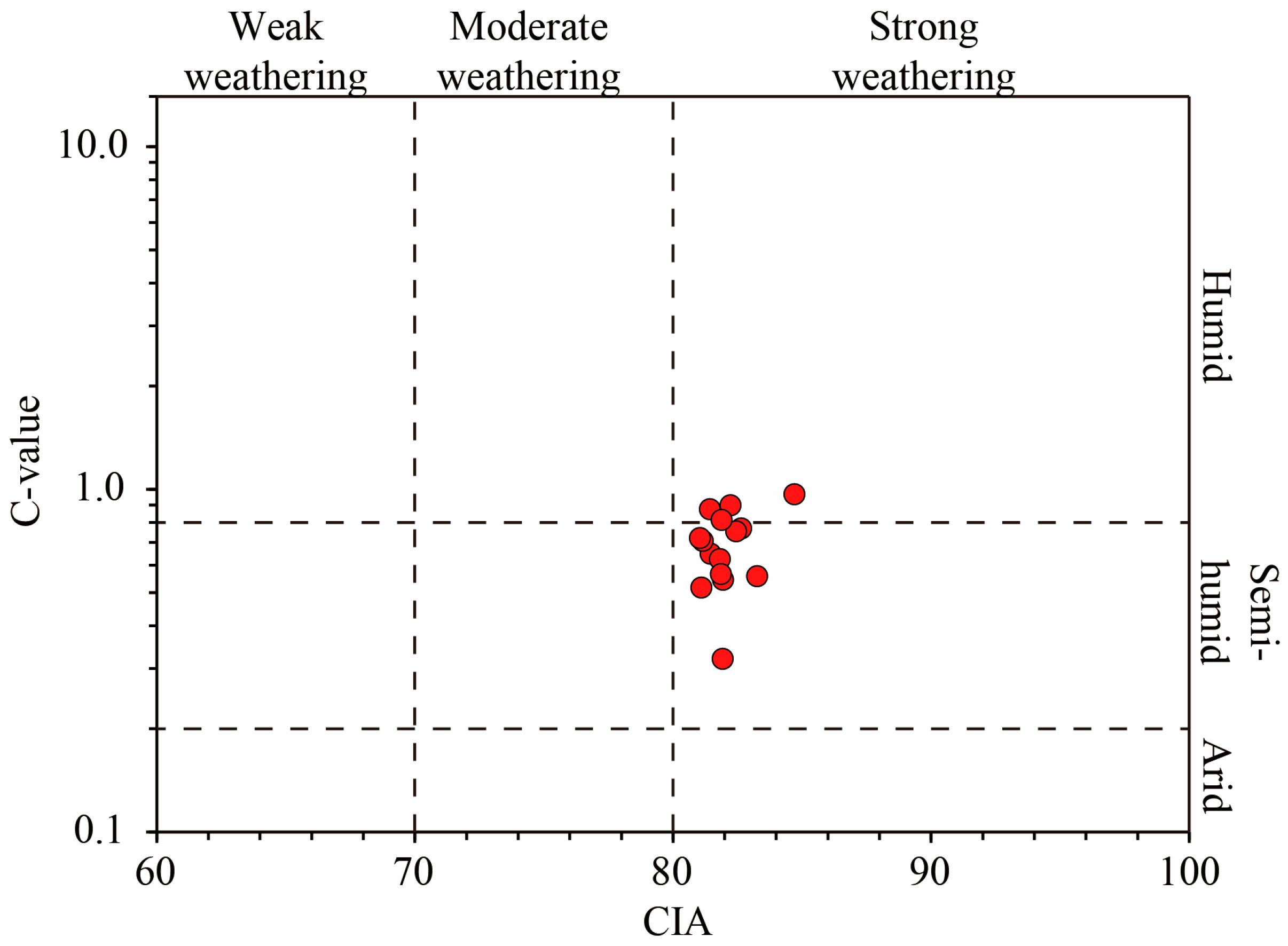
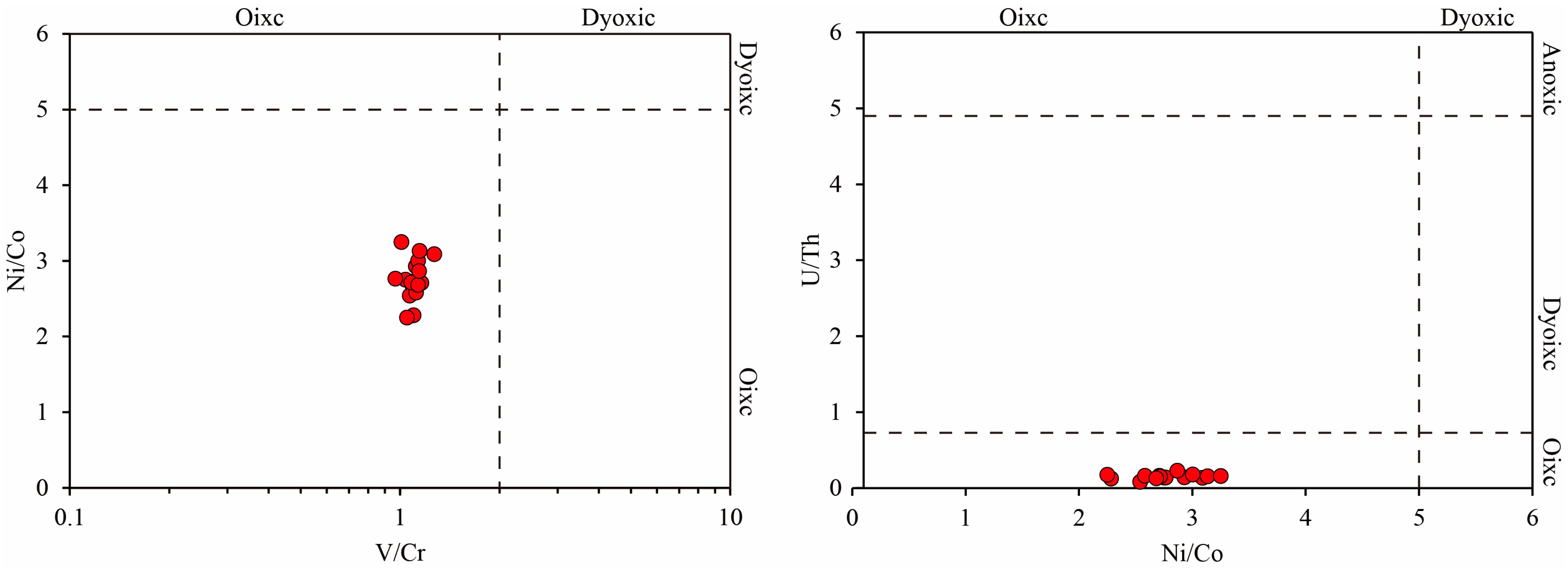
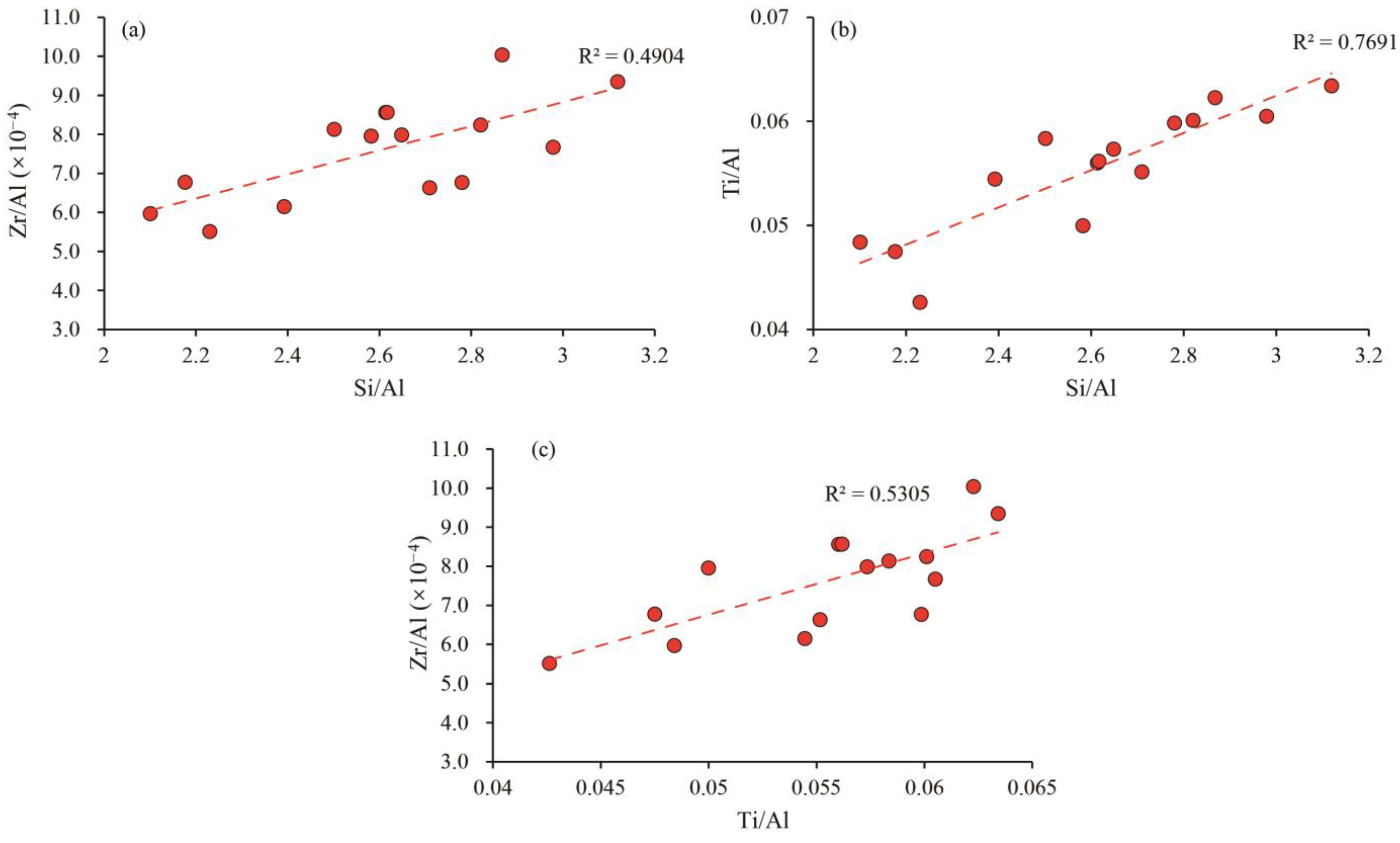
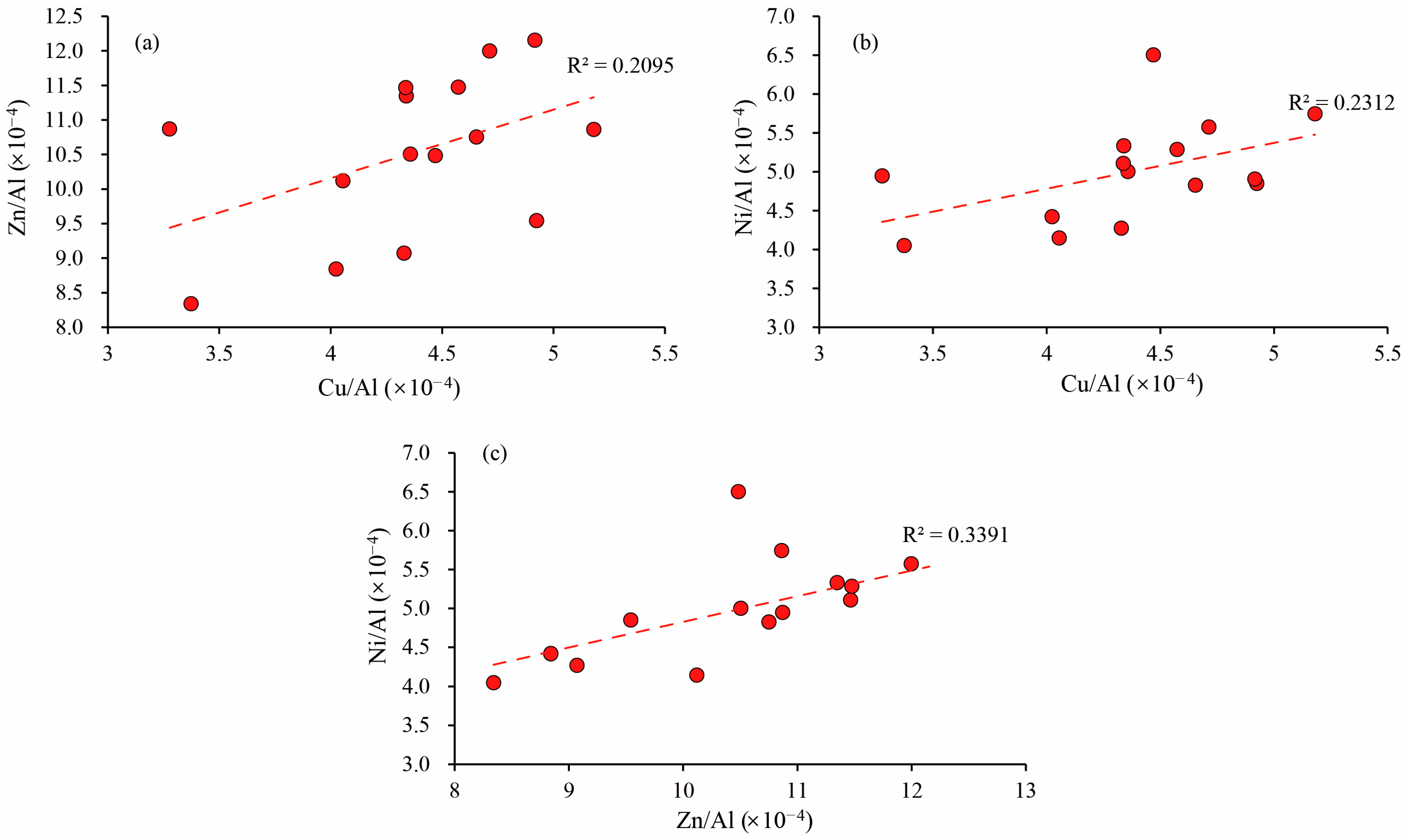
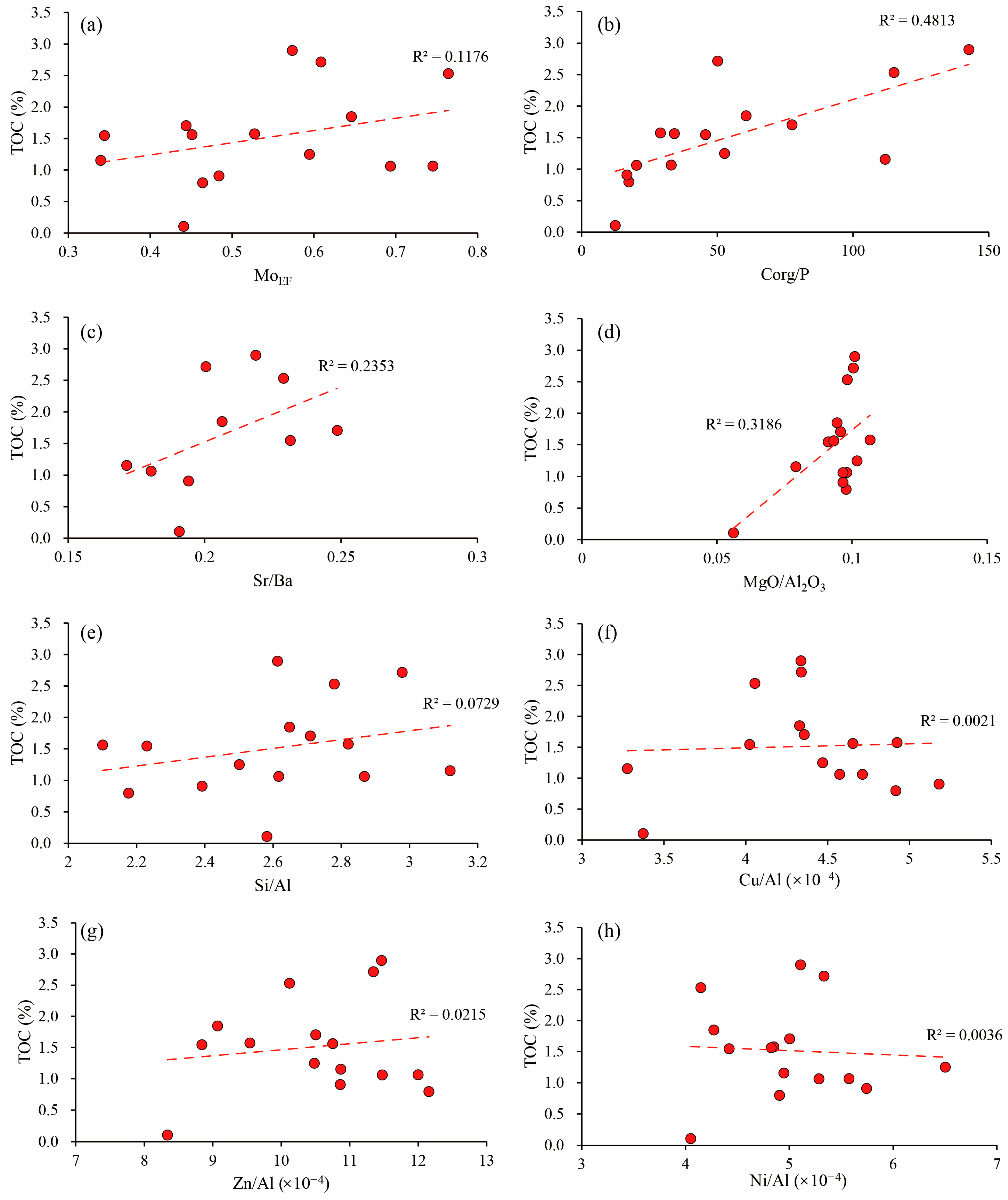
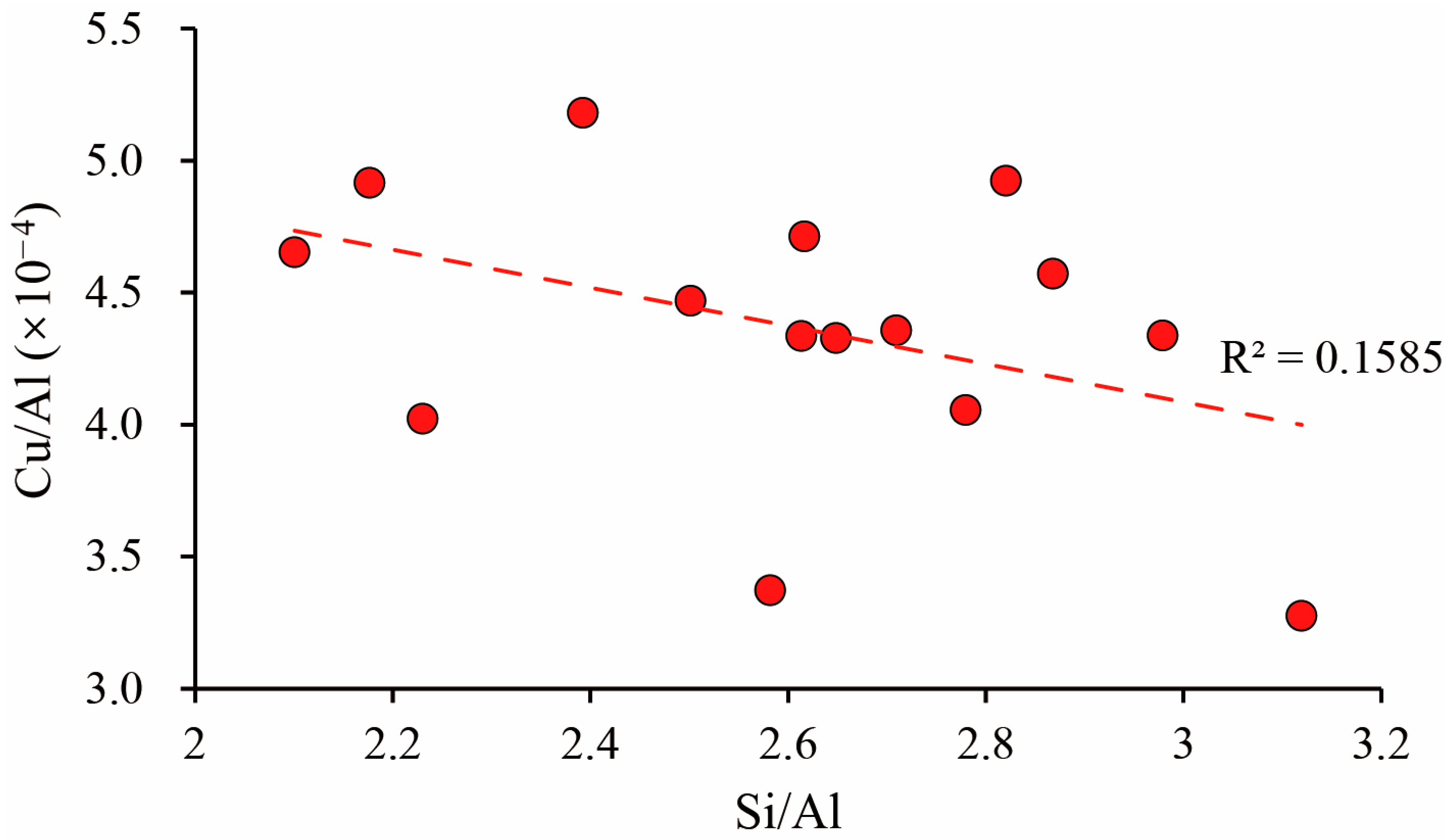
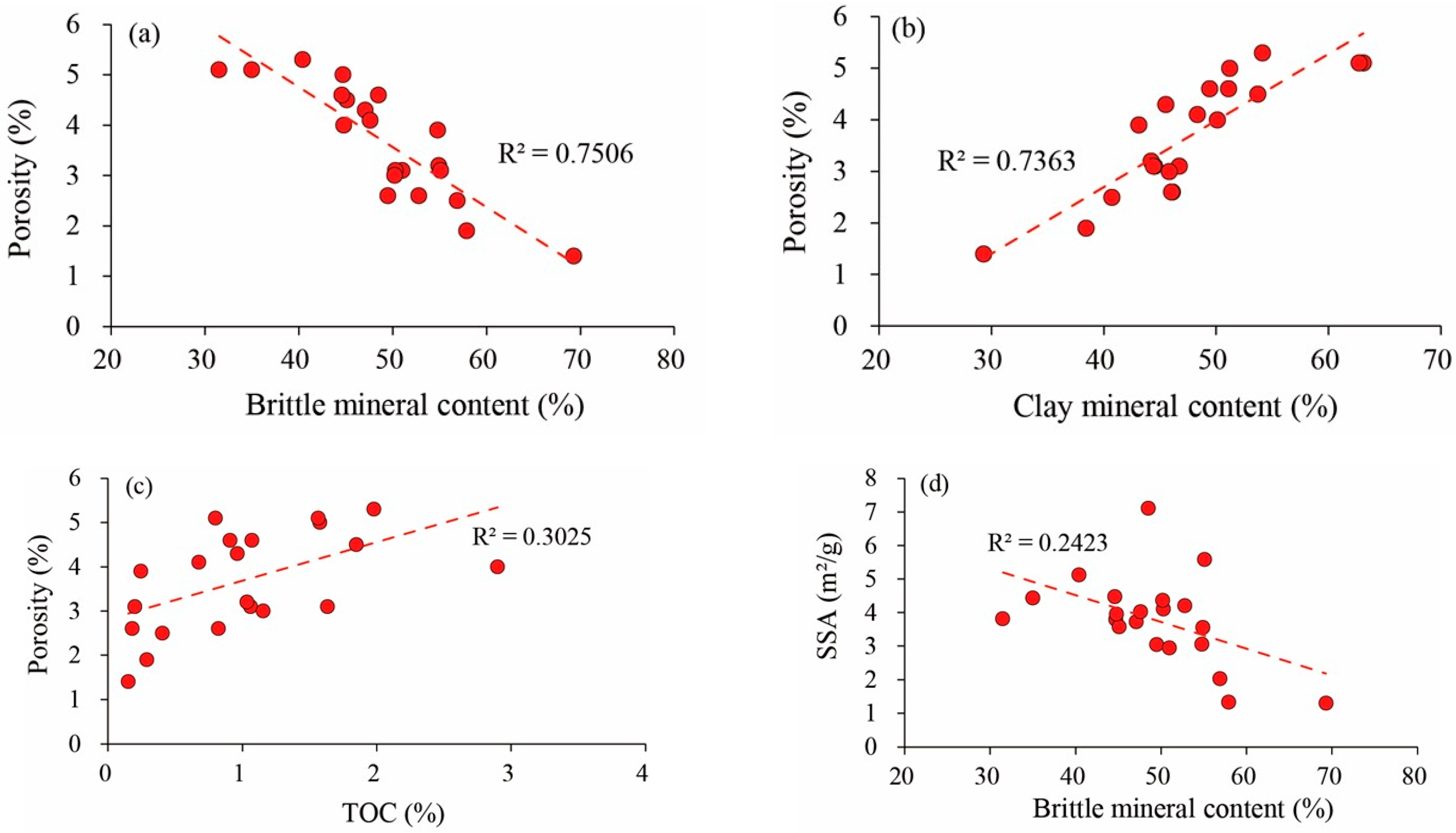
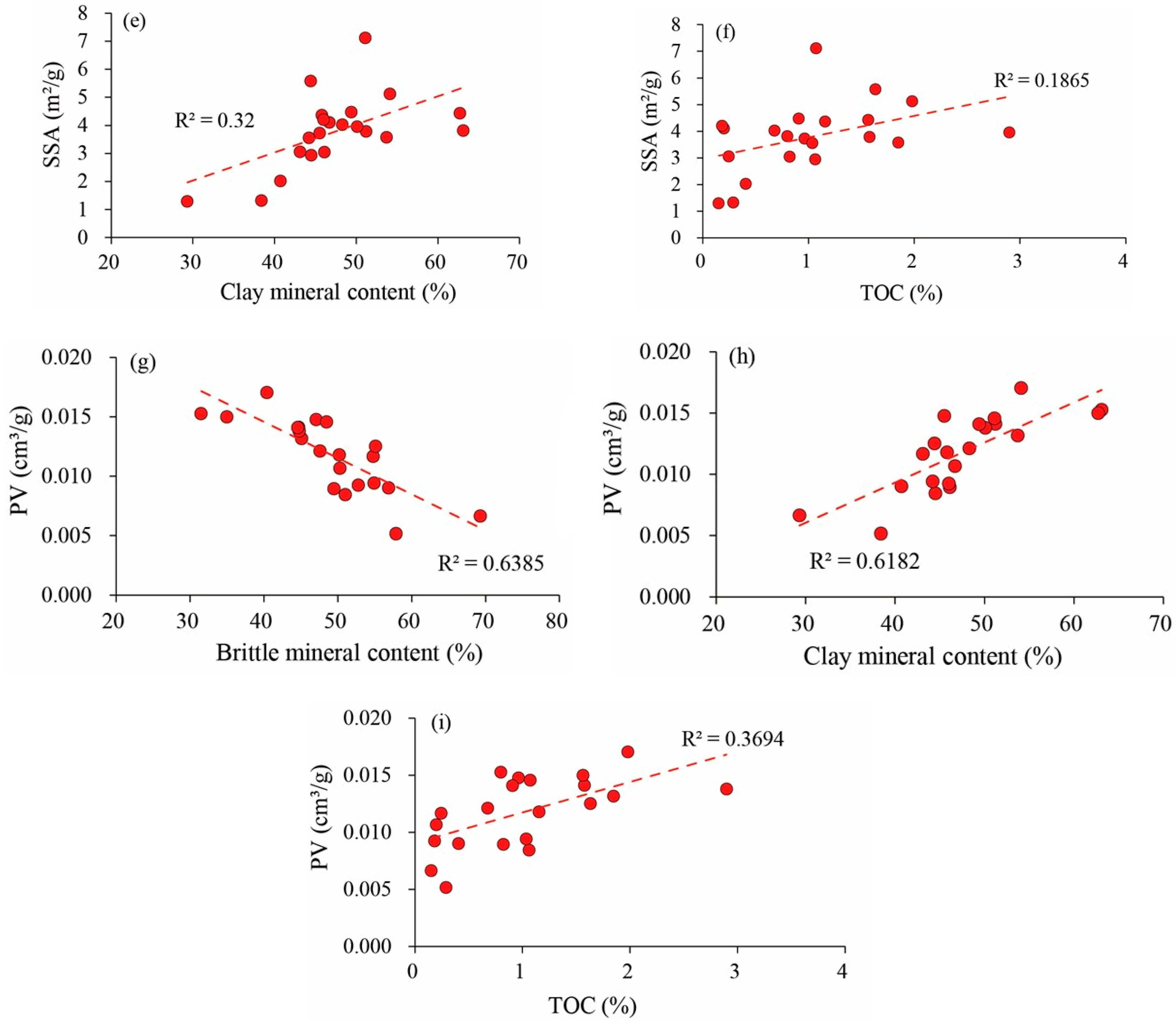
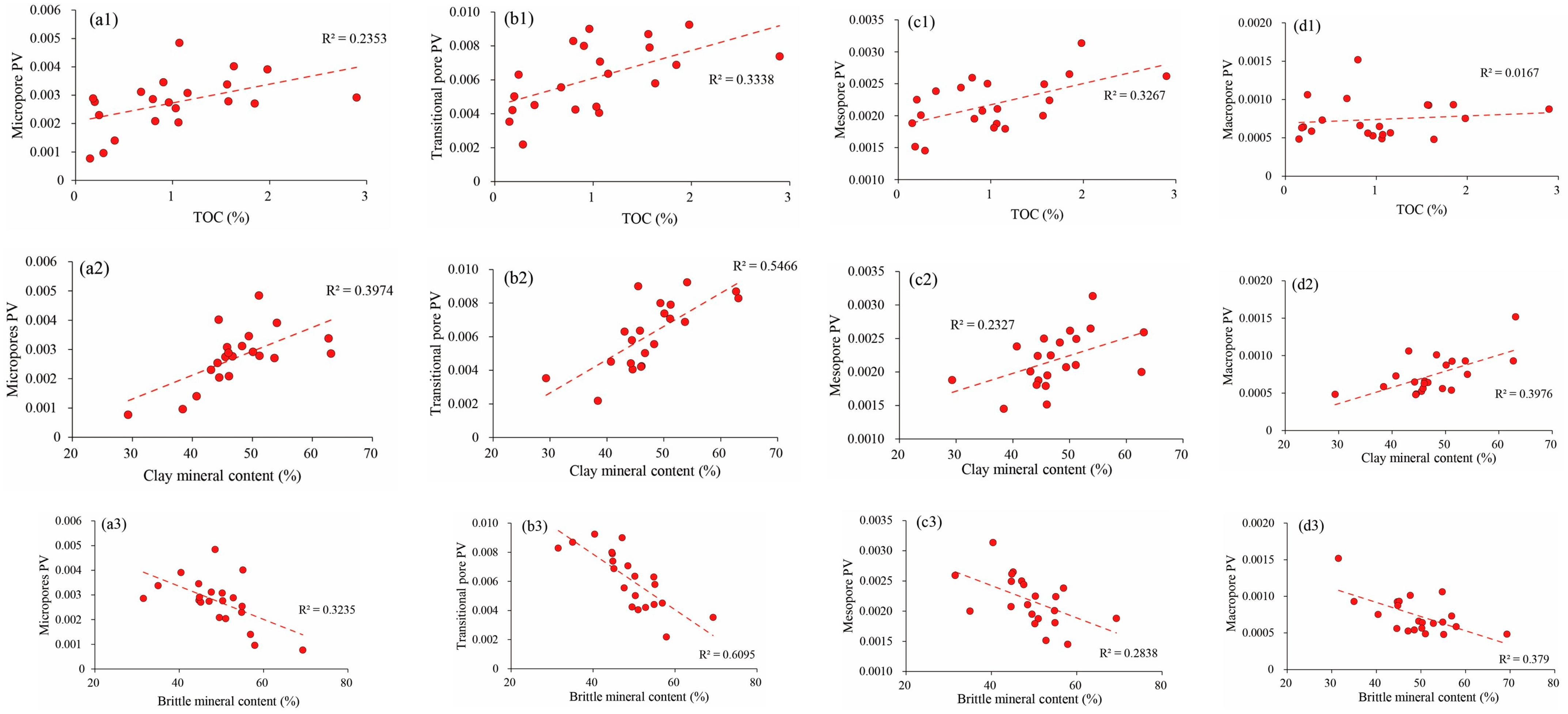

| Depth (m) | TOC (%) | SiO2 (%) | Al2O3 (%) | MgO (%) | Na2O (%) | K2O (%) | P2O5 (%) | TiO2 (%) | CaO (%) | TFe2O3 (%) | MnO (%) |
|---|---|---|---|---|---|---|---|---|---|---|---|
| 3034.16 | 1.55 | 52.48 | 20.74 | 1.89 | 0.53 | 3.66 | 0.20 | 0.78 | 2.65 | 6.00 | 0.04 |
| 3034.72 | 1.58 | 54.91 | 17.16 | 1.83 | 0.55 | 2.90 | 0.32 | 0.91 | 4.60 | 5.28 | 0.06 |
| 3036.55 | 1.71 | 56.84 | 18.49 | 1.77 | 0.60 | 2.91 | 0.13 | 0.90 | 3.11 | 5.49 | 0.04 |
| 3036.85 | 1.25 | 48.50 | 17.09 | 1.74 | 0.50 | 2.59 | 0.14 | 0.88 | 5.75 | 8.35 | 0.13 |
| 3037.12 | 1.85 | 57.60 | 19.17 | 1.81 | 0.61 | 2.86 | 0.18 | 0.97 | 1.66 | 5.50 | 0.05 |
| 3037.30 | 2.53 | 55.54 | 17.61 | 1.73 | 0.65 | 2.79 | 0.13 | 0.93 | 3.10 | 6.10 | 0.07 |
| 3038.00 | 2.72 | 58.87 | 17.42 | 1.75 | 0.63 | 2.82 | 0.32 | 0.93 | 1.38 | 6.22 | 0.07 |
| 3038.45 | 2.90 | 55.18 | 18.61 | 1.88 | 0.62 | 3.11 | 0.12 | 0.92 | 2.59 | 6.20 | 0.06 |
| 3040.00 | 1.06 | 55.10 | 18.56 | 1.82 | 0.55 | 3.13 | 0.19 | 0.92 | 1.78 | 6.72 | 0.08 |
| 3042.28 | 0.80 | 42.42 | 17.18 | 1.68 | 0.38 | 3.03 | 0.27 | 0.72 | 11.66 | 5.51 | 0.05 |
| 3042.93 | 1.56 | 49.10 | 20.60 | 1.92 | 0.42 | 3.70 | 0.27 | 0.88 | 4.34 | 5.94 | 0.04 |
| 3044.38 | 0.91 | 54.23 | 19.98 | 1.93 | 0.53 | 3.36 | 0.32 | 0.96 | 1.64 | 6.44 | 0.05 |
| 3051.05 | 1.06 | 53.88 | 16.56 | 1.60 | 0.58 | 2.51 | 0.31 | 0.91 | 5.87 | 6.10 | 0.12 |
| 3059.99 | 1.15 | 63.88 | 18.05 | 1.43 | 0.29 | 2.96 | 0.06 | 1.01 | 0.21 | 5.13 | 0.02 |
| 3064.14 | 0.11 | 61.11 | 20.86 | 1.17 | 0.42 | 3.74 | 0.05 | 0.92 | 0.20 | 3.41 | 0.01 |
| Depth (m) | TOC (%) | V (ppm) | Cr (ppm) | Co (ppm) | Ni (ppm) | Cu (ppm) | Zn (ppm) | Sr (ppm) | Mo (ppm) | Ba (ppm) | U (ppm) | Th (ppm) |
|---|---|---|---|---|---|---|---|---|---|---|---|---|
| 3034.16 | 1.55 | 165.17 | 130.28 | 15.71 | 48.54 | 44.18 | 97.08 | 158.53 | 0.55 | 685.12 | 1.60 | 11.61 |
| 3034.72 | 1.58 | 136.13 | 122.15 | 15.05 | 44.06 | 44.73 | 86.68 | 148.09 | 0.70 | 566.06 | 2.05 | 14.35 |
| 3036.55 | 1.71 | 139.65 | 130.64 | 19.28 | 48.97 | 42.65 | 102.82 | 153.61 | 0.63 | 617.94 | 1.76 | 20.98 |
| 3036.85 | 1.25 | 130.72 | 126.10 | 21.39 | 58.83 | 40.44 | 94.85 | 180.55 | 0.79 | 547.72 | 1.97 | 13.87 |
| 3037.12 | 1.85 | 143.74 | 148.56 | 15.69 | 43.37 | 43.93 | 92.06 | 127.51 | 0.96 | 617.90 | 2.26 | 16.03 |
| 3037.30 | 2.53 | 136.38 | 122.05 | 14.98 | 38.67 | 37.80 | 94.34 | 151.39 | 1.04 | 661.35 | 1.92 | 11.56 |
| 3038.00 | 2.72 | 145.78 | 132.94 | 21.55 | 49.19 | 40.01 | 104.65 | 132.52 | 0.82 | 661.17 | 2.01 | 15.81 |
| 3038.45 | 2.90 | 148.42 | 127.95 | 18.58 | 50.32 | 42.73 | 112.96 | 143.60 | 0.83 | 656.58 | 2.28 | 13.86 |
| 3040.00 | 1.06 | 156.66 | 145.13 | 20.18 | 54.79 | 46.31 | 117.88 | 133.59 | 1.07 | 740.55 | 2.23 | 14.43 |
| 3042.28 | 0.80 | 135.53 | 119.74 | 14.86 | 44.63 | 44.71 | 110.55 | 294.23 | 0.62 | 656.79 | 1.91 | 10.49 |
| 3042.93 | 1.56 | 158.79 | 138.64 | 16.80 | 52.63 | 50.76 | 117.25 | 164.85 | 0.72 | 742.70 | 1.87 | 11.94 |
| 3044.38 | 0.91 | 164.65 | 145.42 | 22.67 | 60.76 | 54.80 | 114.90 | 137.38 | 0.75 | 707.80 | 1.94 | 15.00 |
| 3051.05 | 1.06 | 139.43 | 133.05 | 20.60 | 46.34 | 40.09 | 100.61 | 124.77 | 0.89 | 609.45 | 2.49 | 14.08 |
| 3059.99 | 1.15 | 135.40 | 134.21 | 14.55 | 47.28 | 31.31 | 103.87 | 82.20 | 0.47 | 479.49 | 2.37 | 14.89 |
| 3064.14 | 0.11 | 169.09 | 148.17 | 15.60 | 44.73 | 37.25 | 92.09 | 109.93 | 0.71 | 576.44 | 4.42 | 19.03 |
| Parameters | Micropre (1–10 nm) | Proportion (%) | Transitional Pore (10–100 nm) | Proportion (%) | Mesopore (100–1000 nm) | Proportion (%) | Macropore (>1000 nm) | Proportion (%) |
|---|---|---|---|---|---|---|---|---|
| PV (cm3/g) | 0.0007–0.0048 (0.0027) | 11.5–33.3 (23.0) | 0.0022–0.0092 (0.0061) | 42.2–60.9 (51.2) | 0.0015–0.0031 (0.0022) | 13.3–28.2 (19.3) | 0.0005–0.0015 (0.0007) | 3.6–11.3 (6.5) |
| SSA (m2/g) | 0.7357–6.0336 (2.8237) | 56.8–84.8 (73.2) | 0.3088–1.4340 (0.9144) | 14.6–39.5 (25.3) | 0.0308–0.0774 (0.0481) | 0.7–3.6 (1.5) | 0.0004–0.0014 (0.0007) | <0.1 |
| Member | TOC (%) | Paleoenvironment | Pore System | |||||
|---|---|---|---|---|---|---|---|---|
| Weathering | Salinity Condition | Redox Condition | Porosity | PV | SSA | Pore Type | ||
| Dongyuemiao | 0.11–2.90 (1.51) | Strong (average CIA 82.1) | Freshwater to brackish (average Sr/Ba 0.21) | Oxic environment (average MoEF 0.54) | 1.4–5.3 (3.7) | 0.0052–0.0170 (0.0118) | 1.29–7.12 (3.79) | Mainly CMPs, OMPs have an impact on physical properties. |
| Da’anzhai | 0.1–3.63 (1.56) | Moderate to strong (average CIA 81.7) | Freshwater to brackish (average Sr/Ba 0.21) | Oxic environment (average MoEF 0.80) | 1.3–6.5 (4.5) | 0.0057–0.0157 (0.0110) | 0.79–5.50 (2.40) | Mainly CMPs, the development of OMPs is obviously different and has no obvious influence on physical properties. |
Disclaimer/Publisher’s Note: The statements, opinions and data contained in all publications are solely those of the individual author(s) and contributor(s) and not of MDPI and/or the editor(s). MDPI and/or the editor(s) disclaim responsibility for any injury to people or property resulting from any ideas, methods, instructions or products referred to in the content. |
© 2023 by the authors. Licensee MDPI, Basel, Switzerland. This article is an open access article distributed under the terms and conditions of the Creative Commons Attribution (CC BY) license (https://creativecommons.org/licenses/by/4.0/).
Share and Cite
Wang, E.; Li, Y.; Guo, T.; Xiong, L.; Dong, X.; Wang, T.; Shi, K. Geological Features, Paleosedimentary Environment, and Organic Matter Accumulation Mechanisms of the Lacustrine Shale Oil System: A Case Study of the Jurassic Dongyuemiao Member in the Sichuan Basin. Processes 2023, 11, 2638. https://doi.org/10.3390/pr11092638
Wang E, Li Y, Guo T, Xiong L, Dong X, Wang T, Shi K. Geological Features, Paleosedimentary Environment, and Organic Matter Accumulation Mechanisms of the Lacustrine Shale Oil System: A Case Study of the Jurassic Dongyuemiao Member in the Sichuan Basin. Processes. 2023; 11(9):2638. https://doi.org/10.3390/pr11092638
Chicago/Turabian StyleWang, Enze, Yang Li, Tonglou Guo, Liang Xiong, Xiaoxia Dong, Tong Wang, and Kaibo Shi. 2023. "Geological Features, Paleosedimentary Environment, and Organic Matter Accumulation Mechanisms of the Lacustrine Shale Oil System: A Case Study of the Jurassic Dongyuemiao Member in the Sichuan Basin" Processes 11, no. 9: 2638. https://doi.org/10.3390/pr11092638
APA StyleWang, E., Li, Y., Guo, T., Xiong, L., Dong, X., Wang, T., & Shi, K. (2023). Geological Features, Paleosedimentary Environment, and Organic Matter Accumulation Mechanisms of the Lacustrine Shale Oil System: A Case Study of the Jurassic Dongyuemiao Member in the Sichuan Basin. Processes, 11(9), 2638. https://doi.org/10.3390/pr11092638








